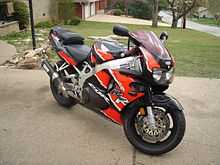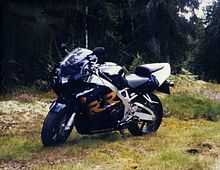Honda CBR900RR
| Manufacturer | Honda |
|---|---|
| Also called | Fireblade |
| Production | 1992-2003 |
| Successor | CBR1000RR |
| Class | Sport bike |
| Related |
Honda CBR600RR Honda CBR1000RR Honda CB900F |
The Honda CBR900RR, also known as the Fireblade in some countries, is a large displacement sport bike introduced in 1992 by Honda. It was the first of a series of large-displacement Honda models to carry the RR suffix. The development of the first generation CBR900RR was led by Tadao Baba.
History
CBR900RR
The first generation RR, the CBR900RR, was introduced in 1992 with an 893 cc (54.5 cu in) inline-four engine set a precedent for light weight in the super bike class. The CBR900RR was based on an advanced research stage model known within Honda as the "CBR750RR". With the objective of equaling the acceleration of competitors’ flagship sport bikes, Honda increased the stroke of its inline 4-cylinder 750cc engine and raised displacement to 893cc. Complementing this excellent power performance were the bike’s dry weight of 185 kg, wheelbase of 1,405 mm and body almost identical to that of the advanced research stage model. At 453 lb (205 kg) with a full fuel tank, the CBR900RR was just 4 lb (2 kg) heavier than Honda's own CBR600F2, and 76 lb (34 kg) lighter than the next-lightest open-class machine at the time, the Yamaha FZR1000.

Numerous changes were made to the second-generation RR, which debuted in 1994, including revised spring and damping rates, a compression adjuster was added to the front fork, an improved shift drum to cure notchy shifting, the upper cowl stay went from steel to aluminum, and the cylinder head cover went from aluminum to magnesium. The styling of the bike also became more aggressive: The independent dual lights became irregular-shaped multi-reflector lights known as "fox eyes" and the bike now featured fewer of the RR's unique fairing holes. In addition, slimmer and firmer footpegs were patterned after the RC45 and a shift linkage replaced the original model's backward pedal. A new instrument panel included an electronic speedometer that measured speed from the countershaft sprocket, rather than the front wheel.

CBR900RR (919)
1996 brought the first major changes to what was now the third generation of the CBR900RR. In order to achieve a more optimized balance of rigidity, Honda significantly altered the 1996 CBR's chassis and suspension. The frame and swingarm were fabricated from larger, thinner-walled extrusions for increased torsional rigidity. The fork and shock internals were re-designed, and the swingarm pivot raised by 5 mm (0.2 in). Revised ergonomics brought the bars 10 mm (0.4 in) higher and swept back five degrees more than earlier models, along with a slimmer gas tank. Engine updates included a bump in displacement to 918 cc (56.0 cu in) via a 1 mm (0.039 in) bore increase, slightly higher compression, a curved radiator, larger exhaust, extra clutch plates, smaller alternator, and the addition of a throttle position sensor. The 1996 model carried over to 1997 unchanged except for the updates to color/graphics offerings.

In 1998, Honda continued subtle refinements in the fourth generation CBR900RR's chassis. It saw frame stiffness closer to the original model's, revised suspension internals, and 5 mm (0.2 in) less triple clamp offset (an almost universal aftermarket upgrade to previous models). New brake calipers acted on larger front discs, the fairing was re-shaped and raised footpegs subtly changed ergonomics again. Eighty percent of the engine's internals were all-new to reduce weight and minimize friction; other updates included redesigned combustion chambers and porting, aluminum composite cylinders, new pistons, a smaller and lighter clutch pack, revised gearbox ratios, larger radiator, and a new stainless steel exhaust header.
CBR900RR (929)
The fifth generation of RR, known as the CBR929RR in North America, was introduced in 2000 and had a completely new 929 cc (56.7 cu in) engine incorporating fuel injection, more oversquare cylinder dimensions, larger valves set at a narrower included angle, lighter internals, and an all-titanium, HTEV-equipped exhaust system. The "pivotless" chassis had the swingarm mounted to the engine cases but incorporated a brace underneath the engine. Updated suspension and brakes included an inverted front fork and 330 mm front discs; and the 16 inch front wheel was replaced with a more common 17 inch wheel.
CBR900RR (954)
The sixth generation of the RR was introduced in 2002 (known as the CBR954RR in North America and Japan), cylinder bore was increased from 74mm to 75mm, increasing capacity to 954 cc (58.2 cu in). Larger fuel injectors and radiator, re-mapped electronic fuel injection, and a more powerful ECU were also added. The bodywork and fairings were reworked for a sleeker, more aerodynamic feel. The frame was strengthened and a more rigid swingarm added and the footpegs were raised to allow for greater lean angles. Front discs increased to 330 mm. Dry weight was reduced to 168 kg (370 lb).
The CBR900RR was replaced by an all new CBR1000RR in 2004.
Specifications
All specifications are manufacturer claimed unless specified.
| Model | CBR900RR (SC28) | CBR900RR (SC28) | CBR919RR (SC33) | CBR929RR (SC44) | CBR954RR (SC50) | |
|---|---|---|---|---|---|---|
| Years | 1992–1993 | 1994–1995 | 1996–1999 | 2000–2001 | 2002–2003 | |
| Engine displacement | 893 cc (54.5 cu in) | 893 cc (54.5 cu in) | 919 cc (56.1 cu in) | 929 cc (56.7 cu in) | 954 cc (58.2 cu in) | |
| Engine type | Inline-4 | |||||
| Stroke | 4 | |||||
| Compression | 11:1 | 11:1 | 11.1:1 | 11.3:1 | 11.5:1 | |
| Bore x stroke | 70.0 mm × 58.0 mm (2.76 in × 2.28 in) | 70.0 mm × 58.0 mm (2.76 in × 2.28 in) | 71.0 mm × 58.0 mm (2.80 in × 2.28 in) | 74.0 mm × 54.0 mm (2.91 in × 2.13 in) | 75.0 mm × 54.0 mm (2.95 in × 2.13 in) | |
| Fuel control | 4x Keihin CV carbs | 4x Keihin CV carbs | 4x 38 mm Keihin CV carbs | PGM-FI (Fuel Injection) w/ Automatic Choke | PGM-FI (Fuel Injection) w/ Automatic Choke | |
| Cooling system | Liquid Cooling | |||||
| Gearbox | 6-speed | |||||
| Final drive | chain | chain | #525 O-Ring Sealed Chain | #530 O-Ring Sealed Chain | #530 O-Ring Sealed Chain | |
| Dry weight | 180 kg (400 lb) | 170 kg (370 lb) | 168 kg (370 lb) | |||
| Seat height | 810 mm (32 in) | 815 mm (32.1 in) | 815 mm (32.1 in) | |||
| Wheelbase | 1,405 mm (55.3 in) | 54.9 in (1,390 mm) | 55.1 in (1,400 mm) | |||
| Front suspension travel | 120 mm (4.7 in) | 120 mm (4.7 in) | 120 mm (4.7 in) | |||
| Rear suspension travel | 120 mm (4.7 in) | 130 mm (5.1 in) | 130 mm (5.1 in) | |||
| Front tyre | 130/70-ZR16 | 130/70-ZR16 | 130/70-ZR16 | 120/70-ZR17 | 120/70-ZR17 | |
| Rear tyre | 180/55-ZR17 | 180/55-ZR17 | 180/55-ZR17 | 190/50-ZR17 | 190/50-ZR17 | |
| Front brakes | Dual disc, 310 mm (12 in) | Dual disc, 330 mm (13 in) | Dual disc, 330 mm (13 in) | |||
| Rear brakes | Single disc, 220 mm (8.7 in) | Single disc, 220 mm (8.7 in) | Single disc, 220 mm (8.7 in) | |||
| Fuel capacity | 18 L (4.0 imp gal; 4.8 US gal) with 2 L (0.44 imp gal; 0.53 US gal) reserve | 18 L (4.0 imp gal; 4.8 US gal) with 3.4 L (0.75 imp gal; 0.90 US gal) reserve | 18 L (4.0 imp gal; 4.8 US gal) with 3.4 L (0.75 imp gal; 0.90 US gal) reserve | |||
| Performance | ||||||
| Max. Power Output (at the crankshaft) | 128.0 hp (95 kW) @ 10,500 rpm[1] | 150.0 hp (112 kW) @ 11,500 rpm[2] | 148.0 hp (110 kW) @ 11,250 rpm[3] | |||
References
- ↑ CBR919RR Specifications motorsports-network.com
- ↑ CBR929RR Specifications motorsports-network.com
- ↑ CBR954RR Specifications motorsports-network.com
External links
| Wikimedia Commons has media related to Honda CBR900RR. |